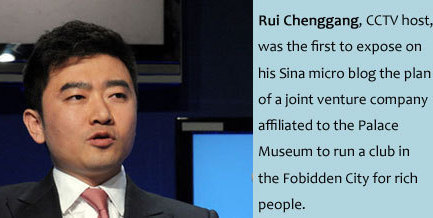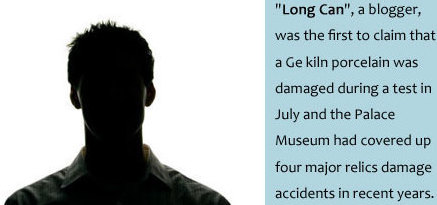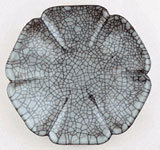Palace Museum Missteps
Updated:2011-08-26 17:33
(chinadaily.com.cn)
|
 |
|
 |
|
Palace Museum, the house of the nation's cultural treasures, also known as Forbidden City, is again in trouble. Less than two months after nine exhibits were stolen in May, a slew of misdoings by museum staffers on the nation's precious relics were exposed to the public and made the whole nation worried, if not shocked. Readers who have been following the news all along may wonder, is the agency who guards and protects the gem of our culture so old and heedless that it cannot take good care of the treasures that have stood the test of time? Or, judging from their response to doubts over the handling of the relics and the planned opening of a private luxury club within the palace walls earlier, can we just raise the question - are they abusing their right to the heritage site? |
|
 |
|
Burglary On May 9, several works of art on loan from a Hong Kong collector, which were valued at 10 million yuan ($1.54 million), went missing from an exhibition in the Forbidden City's historic Palace Museum. Police recovered several of the items, but not before Chinese citizens expressed shock and outrage over lax security in the Forbidden City. |
|
Wrongly written character On May 13, the Palace Museum honored the Beijing Municipal Bureau of Public Security with a silk banner to commend them for their work in cracking the burglary case. But instead of the Chinese character han, which means to protect, it had a homophone, which means to shake. On May 14, the Palace Museum refused to admit the mistake; but on May 16, it apologized on its micro blog. |
Exclusive Club On May 11, presenter Rui Chenggang of China Central Television (CCTV) exposed on his micro blog that Jianfu Hall within the Forbidden City was to be turned into an exclusive club, for which 500 memberships would be sold worldwide. The Palace was dragged into the worsening scandals. |
On July 4, the Celadon Plate with a Mouth in the Shape of Mallow Petals, a first-class Ge ware national treasure of the Song Dynasty (960-1279), broke into six pieces when a researcher made a wrong adjustment to the testing device during a pressure test. The museum did not report or admit the incident until July 31, after it was exposed by a blogger named "Longcan". >>> |
|
On Aug 2, the same "Longcan" revealed that the Palace Museum had covered up four other accidents in which important artifacts had been damaged in recent years. >>> |
Damaged wall panel A report said a rosewood bird-and-flower wall panel with jade inlay work, part of the collection of the Qing court, was soaked and damaged during repair.
|
Hush money A report said some employees of the museum had pocketed ticket revenues in 2009. Their actions were filmed by a witness who asked the museum for 200,000 yuan ($31,300) in hush money. The museum compromised and gave 100,000 yuan to cover up the scandal. |
|
Ancient book An informer, who claimed to be part of the Palace Museum staff, reported the loss of some ancient books in the museum library. |
On Aug 5, another rumor said the Palace Museum had bought five rare Song Dynasty letters (pictured below) during an auction in 1997. But in 2005, the five letters showed up again on the auction market and were sold for three times the price they had fetched in 1997. >>> |
Tax evasion A report said tickets to commercial exhibitions held outside Duanmen Gate do not contain the tax stamp, which puts the Palace Museum under suspicion of tax evasion. |
|
 |
|
|
Located in the center of Beijing, the Palace Museum, historically and artistically one of the most comprehensive museums in China, was established on the grounds of Forbidden City, a palace of the Ming and Qing dynasties and their collection of treasures.
|
|
|




 The Palace Museum's efforts at a cover-up before admitting that a priceless porcelain dish had been broken by accident make people believe the public would've been fooled if not for Internet users' exposure and media reports, said commentator Zhang Tianpan in Nanfang Daily.
The Palace Museum's efforts at a cover-up before admitting that a priceless porcelain dish had been broken by accident make people believe the public would've been fooled if not for Internet users' exposure and media reports, said commentator Zhang Tianpan in Nanfang Daily.